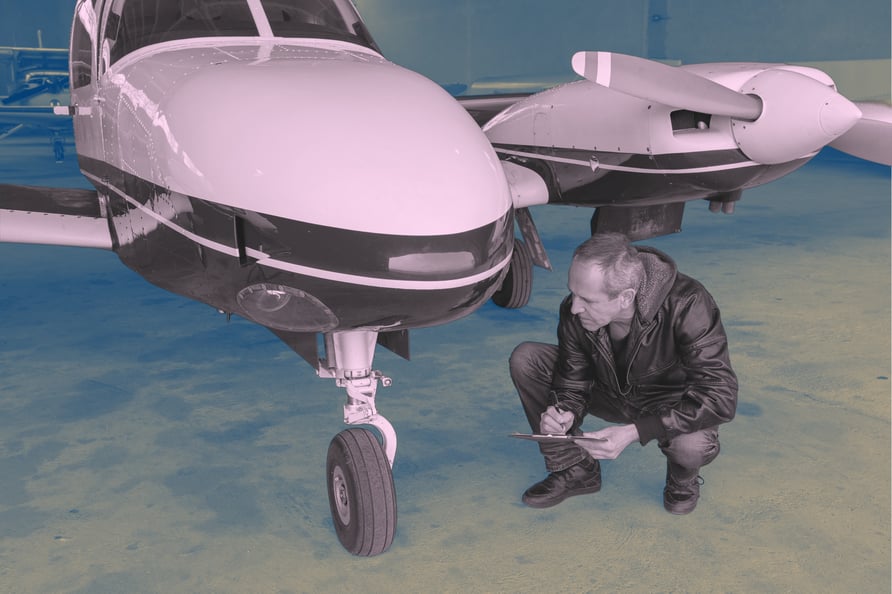Share this
Move Slow and Don’t Break Things
by Friday Morning Flight Plan at [date]

When you begin flight training, there’s a lot you don’t yet know—including what “damage” looks like on the airplane you’re renting. Even after you’ve earned your certificate, when the airplane isn’t your own, it still deserves extra attention.
Let’s be honest: most shared-use airplanes have a few scars. A little hangar rash, some cracked fairing plastic, a missing screw, maybe a small dent or two. None of that necessarily means the airplane isn’t airworthy—but it does mean you need to know what’s normal, and what’s not.
More Than Just a Walk-Around
Think of the preflight inspection like checking a rental car for scratches before you drive off the lot. The big difference? Your airplane inspection is guided by an aircraft-specific checklist—often performed as a flow. Oh, and the stakes are much higher.
If you’re interrupted during preflight, back up three items on the checklist before resuming. It’s a simple habit that helps prevent missed steps.
Pro Tip: Consider checking the fuel level first. That way, if you need to call the fuel truck, you can do it early and give them time to arrive while you complete the rest of your inspection.
Always use the aircraft’s specific checklist. If you don’t have one, refer to the Pilot’s Operating Handbook (POH)—it’s required by regulation to be on board.
Protect the Battery
If the checklist calls for lowering the flaps or turning on electrical items, go ahead—but move quickly. Check what you need to check, then turn everything off so you don’t drain the battery.
Leave the flaps down after testing, since you’ll need them down to inspect hinges and tracks.
What You’re Looking For
During preflight, you’re checking for any discrepancies: missing screws, flat spots on tires, cracks in fairings, leaking oil, or missing placards. There’s no shortcut here—take the time it takes.
Keep small items like the control lock, pitot cover, and fuel sampler in consistent spots so you can find them quickly. And know how your school, club, or FBO disposes of sumped fuel—some have collection containers; others (less ideally) just dump it on the ground.
Pro Tip: If you find something questionable, leave the left wing tie-down in place until you’ve talked to a mechanic. It’s a simple visual cue that reminds you there’s an open issue before flight.
Ask, Don’t Assume
Never hesitate to point out potential issues to maintenance personnel or an instructor. What looks like a new crack might be old cosmetic damage—or it could be something serious, like structural stress or a developing oil leak.
If you find a problem (“squawk”), follow the maintenance reporting procedure—whether that’s a paper binder, a dispatch sheet, or an electronic form.
It’s never fun to scrub a flight, but making that call is part of being the PIC. It’s not a sign of bad luck—it’s a sign of good judgment.
Share this
- Preflight Planning (25)
- ADM (15)
- Pilot Proficiency (15)
- Regulations (9)
- ATC Communications (8)
- IFR Proficiency (6)
- Emergency Procedures (5)
- Instrument Proficiency (5)
- VFR Proficiency (5)
- Weather (5)
- VFR Into IMC (3)
- Aviation History (2)
- Crosswind Landings (2)
- Emergencies (2)
- Icing (2)
- Laser Strikes (2)
- Night Flying (2)
- Aerial photography (1)
- Aerobatic Flying (1)
- Flying Clubs (1)
- GPS (1)
- High Performance Endorsement (1)
- Instrument Rating (1)
- Post-flight Inspection (1)
- Radio Problems (1)
- Rotor-Wing (1)
- SRM (1)
- TFRs (1)
- Transition Training (1)
- Wake Turbulence (1)
- Winds (1)
- iPad Ops (1)
- November 2025 (1)
- October 2025 (5)
- September 2025 (4)
- August 2025 (4)
- July 2025 (2)
- June 2025 (4)
- May 2025 (5)
- April 2025 (4)
- March 2025 (3)
- February 2025 (4)
- January 2025 (5)
- December 2024 (3)
- November 2024 (3)
- October 2024 (5)
- September 2024 (3)
- August 2024 (5)
- July 2024 (3)
- June 2024 (4)
- May 2024 (5)
- April 2024 (4)
- March 2024 (3)
- February 2024 (5)
- January 2024 (4)
- December 2023 (3)
- November 2023 (4)
- October 2023 (5)